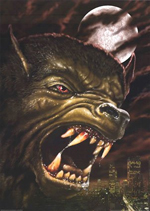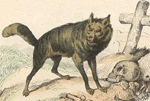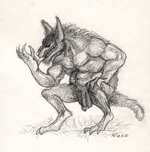
According to mythology and folklore the Werewolf, also sometimes called a lycanthrope or wolfman, is a person who shape shifts his or her self into a wolf, either at will, by using a form of magic, or after being placed under a curse. The term Werewolf was most likely derived from the Old English word, wer and wulf, wer meaning man and wulf meaning wolf, so Werewolf literally translates into man wolf.
The Greek term Lycanthropy is also commonly used for the physical transformation of the man into the wolf and vies versa. The medieval chronicler Gervase of Tilbury associated this transformation with the appearance of the full moon, but that concept was rarely associated with the Werewolf until the idea was picked up by modern fiction writers. These modern writers also gave us the idea that the Werewolf can be killed by a silver bullet, although this was not a feature of folk legends. In fact much of the information found in modern day Werewolf movies is not based off of the old legends, however the legend of the Werewolf has been around for centuries.  Many European countries and cultures have stories of Werewolves, this list includes France’s, loup-garou, The Greek lycanthropes, Spain’s hombre lobo, Bulgaria’s varkolak and vulkodlak, Czech Republic’s vlkodlak, Serbia’s vukodlak, Russia’s oboroten', Ukraine’s vovkulak, vurdalak, vovkun or pereverten' , Croatia’s vukodlak, Poland’s wilkolak, Romania’s vârcolac, Scotland’s werewolf or wulver, England’s werewolf, Ireland’s faoladh or conriocht, Germany’s Werwolf, Holland’s weerwolf, Denmark, Sweden and Norway’s Varulv, Norway and Iceland’s kveld-ulf or varúlfur, Galicia’s lobisón, Portugal and Brazil’s lobisomem, Lithuania’s vilkolakis and vilkatlakis, Latvia’s vilkatis and vilkacis, Andorra’s home llop, Estonia’s libahunt, Finland’s ihmissusi and vironsusi, and Italy’s lupo mannaro. All of these locations had there own stories of wolf men, and in northern Europe there were tales of people who could change into other animals including bears and wolves.
Many European countries and cultures have stories of Werewolves, this list includes France’s, loup-garou, The Greek lycanthropes, Spain’s hombre lobo, Bulgaria’s varkolak and vulkodlak, Czech Republic’s vlkodlak, Serbia’s vukodlak, Russia’s oboroten', Ukraine’s vovkulak, vurdalak, vovkun or pereverten' , Croatia’s vukodlak, Poland’s wilkolak, Romania’s vârcolac, Scotland’s werewolf or wulver, England’s werewolf, Ireland’s faoladh or conriocht, Germany’s Werwolf, Holland’s weerwolf, Denmark, Sweden and Norway’s Varulv, Norway and Iceland’s kveld-ulf or varúlfur, Galicia’s lobisón, Portugal and Brazil’s lobisomem, Lithuania’s vilkolakis and vilkatlakis, Latvia’s vilkatis and vilkacis, Andorra’s home llop, Estonia’s libahunt, Finland’s ihmissusi and vironsusi, and Italy’s lupo mannaro. All of these locations had there own stories of wolf men, and in northern Europe there were tales of people who could change into other animals including bears and wolves.
In Greek mythology the story of Lycaon supplies one of the earliest examples of a werewolf legend. According to one telling of the legend, Lycaon, king of Arcadia during the time of the ancient Greeks, was transformed into a wolf as a result of eating human flesh; another telling of the Lycaon legend states that he tried to buy the favor of Zeus by offering him the flesh of a young child, repulsed Zeus punished Lycoan by turning him into a wolf.  In Norse mythology, the legends of ulfhednar mentioned in the Vatnsdśla saga, there were vicious fighters, analogous to the better known berserker, who dressed in wolf hides and where said to channel the spirits of these animals, enhancing their own power and ferocity in battle. They were even said to be immune to pain and would kill viciously in battle, like a wild animal.
In Latvian mythology, the Vilkacis was a person who would changed into a wolf like monster.
In Norse mythology, the legends of ulfhednar mentioned in the Vatnsdśla saga, there were vicious fighters, analogous to the better known berserker, who dressed in wolf hides and where said to channel the spirits of these animals, enhancing their own power and ferocity in battle. They were even said to be immune to pain and would kill viciously in battle, like a wild animal.
In Latvian mythology, the Vilkacis was a person who would changed into a wolf like monster.
Many of the Werewolves in European tradition were innocent and God fearing persons, who suffered through the witchcraft of others, or simply from an unhappy fate, and who as wolves behaved in a truly touching fashion, fawning upon and protecting their benefactors. In Marie de France's poem Bisclaveret, the nobleman Bisclavret, for reasons not described in the lai, had to transform into a wolf every week. When his treacherous wife stole his clothing, needed to restore his human form, he escaped the king's wolf hunt by imploring the king for mercy, and accompanied the king thereafter.  His behavior at court was so gentle and harmless than when his wife and her new husband appeared at court, his attack on them was taken as evidence of reason to hate them, and the truth was revealed. Other individuals similar to this was the hero of William and the Werewolf, translated from French into English about 1350, and the numerous princes and princesses, knights and ladies, who appear temporarily in beast form in the German fairy tales, or Märchen.
His behavior at court was so gentle and harmless than when his wife and her new husband appeared at court, his attack on them was taken as evidence of reason to hate them, and the truth was revealed. Other individuals similar to this was the hero of William and the Werewolf, translated from French into English about 1350, and the numerous princes and princesses, knights and ladies, who appear temporarily in beast form in the German fairy tales, or Märchen.
Some werewolf lore is based on documented events. The Beast of Gévaudan was a creature that reportedly terrorized the general area of the former province of Gévaudan, in today's Lozčre department, in the Margeride Mountains in south central France, in the general timeframe of 1764 to 1767. It was often described as a giant wolf and was said to attack livestock and humans indiscriminately. In the late 1990s, a string of man eating wolf attacks were reported in Uttar Pradesh, India. Frightened people claimed, among other things, that the wolves were Werewolves.  Historical legends describe a wide variety of methods for becoming a werewolf. One of the simplest was the removal of clothing and putting on a belt made of wolf skin, probably a substitute for the assumption of an entire animal skin which also is frequently described. In other cases the body is rubbed with a magic salve. To drink water out of the footprint of the animal in question or to drink from certain enchanted streams were also considered effectual modes of accomplishing metamorphosis.
Historical legends describe a wide variety of methods for becoming a werewolf. One of the simplest was the removal of clothing and putting on a belt made of wolf skin, probably a substitute for the assumption of an entire animal skin which also is frequently described. In other cases the body is rubbed with a magic salve. To drink water out of the footprint of the animal in question or to drink from certain enchanted streams were also considered effectual modes of accomplishing metamorphosis.
Olaus Magnus says that the Livonian Werewolves were initiated by draining a cup of specially prepared beer and repeating a set formula. Another theory is to be born on the 24th of December, and the child shall be born a werewolf. The most common modern belief is to be directly bitten by a werewolf, where the saliva enters the blood stream. Becoming a werewolf simply by being bitten by another werewolf as a form of contagion is common in modern fiction, but rare in legend, in which werewolf attacks seldom left the victim alive to transform.
According to The Book of Werewolves by Sabine Baring-Gould, a Russian spell to transform into a werewolf, referred to as Oborot in the text, is as follows:
“He who desires to become an oborot, let him seek in the forest a hewn-down tree, let him stab it with a small copper knife, and walk round the tree, repeating the following incantation:”
On the sea, on the ocian, on the island, on Bujan,
On the empty pasture gleams the moon, on an ashstock lying
In a green wood, in a gloomy vale.
Towards the Stock wandereth a shaggy wolf,
Horned cattle seeking for his sharp white fangs,
But the wolf enters not the forest,
But the wolf dives not into the shadowy vale,
Moon, moon, gold horned moon,
Check the flight of bullets, blunt the hunters’ knives,
Break the shepherds’ cudels,
On men, all creeping things,
They may not catch the grey wolf,
That they may not rend his warm skin!
My word is binding, more binding than sleep,
More binding than the promise of a hero!
“Then he springs thrice over the tree and runs into the forest, transformed into a wolf.”
In Galician, Portuguese and Brazilian folklore, it is the seventh of the son, but sometimes the seventh child, a boy, after a line of six daughters, who becomes a werewolf. In Portugal, the seventh daughter is supposed to become a witch and the seventh son a werewolf; the seventh son often gets the Christian name, Bento, Portuguese form of Benedict, meaning blessed, as this is believed to prevent him from becoming a werewolf later in life.
In Brazil, the seventh daughter become a headless, the head being replaced with fire, horse called Mula-sem-cabeça. The belief in the curse of the seventh son was so extended in Northern Argentina, that seventh sons were often abandoned, ceded in adoption or killed. A law from 1920 decreed that the President of Argentina is to be the godfather of every seventh son. Thus, the State gives that son a gold medal during his baptism and a scholarship until his 21st year. This ended the abandonments, but it is still traditional that the President godfathers seventh sons.
Various methods also existed for removing the beast shape. The simplest was the act of the enchanter, operating either on himself or on a victim, and another was the removal of the animal belt or skin. To kneel in one spot for a hundred years, to be reproached with being a werewolf, to be saluted with the sign of the cross, or addressed thrice by baptismal name, to be struck three blows on the forehead with a knife, or to have at least three drops of blood drawn have also been mentioned as possible cures. Many European folk tales include throwing an iron object over or at the werewolf, to make it reveal its human form.
.A recent theory has been proposed to explain werewolf episodes in Europe in the 18th and 19th centuries. Ergot, which causes a form of food borne illness, is a fungus that grows in place of rye grains in wet growing seasons after very cold winters. Ergot poisoning usually affects whole towns or at least poor areas of towns and results in hallucinations, mass hysteria and paranoia, as well as convulsions and sometimes death., the drug LSD can be derived from ergot. Ergot poisoning has been proposed as both a cause of an individual believing that he or she is a werewolf and of a whole town believing that they had seen a werewolf. However, this theory is controversial and not well accepted.
Some modern researchers have tried to use conditions such as rabies, hypertrichosis, and excessive hair growth over the entire body, or porphyria, an enzyme disorder with symptoms including hallucinations and paranoia, as an explanation for Werewolf beliefs. Congenital erythropoietin porphyria has clinical features which include photosensitivity. Making it so sufferers can only go out at night, hairy hands and face, poorly healing skin, pink urine, and reddish color to the teeth.
There is also a rare mental disorder called clinical lycanthropy, in which an affected person has a delusional belief that he or she is transforming into another animal, although not always a wolf or werewolf. Others believe Werewolf legends arose as a part of shamanism and totem animals in primitive and nature based cultures. The term therianthropy has been adopted to describe a spiritual concept in which the individual believes he or she has the spirit or soul, in whole or in part, of a non-human animal.
With so many different theories and assumptions as to the origins of the Werewolf and its many legends we many never truly know just where it all started. But the fact remains that something did start the legend, a legend which spread over the globe. Was it just a case of mistaken Identity, of a large rogue wolf which prayed upon small villages or could it have been as legend suggests, an actually transformation of man to beast.
The Evidence
No physical evidence exists to date that would prove the existence of the Werewolf, in the present or in the past.
The Sightings
The only sightings of werewolves reported took place during medieval sieges or came up as folklore and story typically involving stressful time periods. No modern day accounts of actual true werewolf sightings have been reported.
The Stats – (Where applicable)
• Classification: Hybrid
• Size: Varies greatly depending on the legend and region
• Weight: Unknown
• Diet: Carnivorous
• Location: World Wide
• Movement: Walking
• Environment: Judging from the many legends, it would appear that the Werewolf can exist in almost any environment on earth.
|